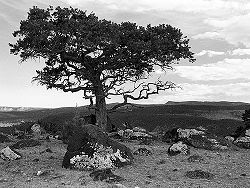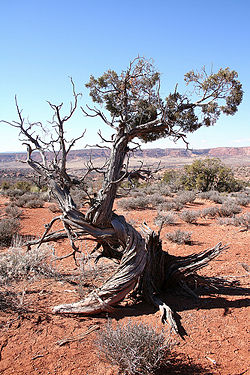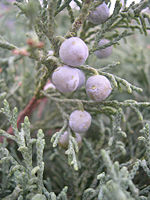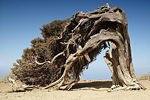Juniper
| Juniper |
|---|

|
| Scientific Classification |
|
| Species |
|
Junipers are evergreen trees perhaps best known for their use in construction wood, but they can also be helpful for fuel production, and has been used for medicinal and spiritual purposes as well. This tree can date back to possibly 2000 years ago. [1] The juniper tree is a source to the mistletoe plant which is a parasite but assists in the reproduction of Junipers.[2] They are possibly the most widely distributed tree. The juniper tree is referred to in the Bible as a plant used for food for the poor.
Anatomy
Juniper trees are evergreen shrubs or trees. [3] They have a wide range in size. Some are between 2 and 5 feet tall and 7-13 feet wide, but in other cases, they can be found up to 25 feet tall. [4] The trees usually consist of between 4 and 6 small angled branches. The leaves have alternating, opposite pairs in 4 different ranks. Sometimes they consist of alternating whorls of 3-6 ranks. [5] The young leaves are needle-like and typically yellow or green in color, but as they mature, they brown, harden and become scaly. The bark on the outside becomes thin strips and the leaves sometimes secrete a strange odor. [6] Their leaves are typically scale-like and sometimes they secrete a crystalline white substance. Extensive amounts of research have not been put into studying the Junipers but so far, J. Drupacea is the tallest and J. scopulorum is the oldest. The J. scopulorum has survived for what is believed to be about 2000 years. The Juniper trees are rarely inured by insects. [7]
Reproduction
The trees are typically dioecious which means that there are separate male and female trees. Rarely, these trees are hermaphroditic. The tree begins to produce seeds between 10 and 30 years of age but when the tree is within 50 to 200 years, it is in prime growth time. [8]The cones are typically fleshy and have hard shelled seeds. The most common dispersal of seeds are through birds. [9] The fruits that these trees produce are oftentimes berrylike and red. [10]. The seeds are spherical and sometimes berrylike. [11] Usually they mature within 1-2 growing seasons. They germinate over long periods of time and the rates at which they do so are slow. Inside the round shaped fruit is usually about 1 to 2 seeds and they remain with the fruits for 2 years. Seeds are commonly dispersed through gravity, water and most commonly, birds. [12]. Ninety-five percent of reproduction can be attributed to birds. When a seed comes out of a bird’s digestive system, it aids in the germination process. [13] Dormant embryos have semipermeable seed coats. [14]. If a seed is found in a drought before it has the opportunity to germinate, it is not harmed and becomes productive as soon as conditions become favorable again. [15] It is common to have defective seeds. [16]
Ecology
The Juniper trees are found mainly in the Northern Hemisphere in places such as in the Western USA, Northern Mexico, and in parts of Asia. [17] The Junipers are probably the most widely distributed tree. They are found in dry, rocky, wooded hills and even on slopes. [18] They can survive amazingly well even after fires. [19]
Mistletoe
Mistletoe plants grown on the Juniper tree as a parasite. Mistletoes attract many animals to eat their seeds which helps with the dispersal of juniper seeds. It is able to do this because the having the mistletoe nearby attracts other animals which eat the juniper seeds and disperses them all over. [20] They are about 6-15 inches in diameter which are tiny and scalelike. These parasites are also dioecious. [21]
In the Bible
The "brush tree" is referred to in the Bible as something the poor would eat. It grew in Arabia and produced yellow flowers and a bitter root.
Job 30:4 In the brush they gathered salt herbs, and their food was the root of the broom tree.
1 Kings 19:4-5 While he himself went a day's journey into the desert. He came to a broom tree, sat down under it and prayed that he might die. "I have had enough, LORD," he said. "Take my life; I am no better than my ancestors." Then he lay down under the tree and fell asleep. All at once an angel touched him and said, "Get up and eat."
Gallery
Rocky Mountain Juniper
(J. scopulorum)
References
- The Gymnosperm Database: Juniperus
- Juniperus communis
- Juniperus monosperma BOTANICAL AND ECOLOGICAL CHARACTERISTICS SPECIES
- Oecologia Springer Link
- rethem Blue Letter Bible
- Juniper Mistletoe Branch & Terminal







